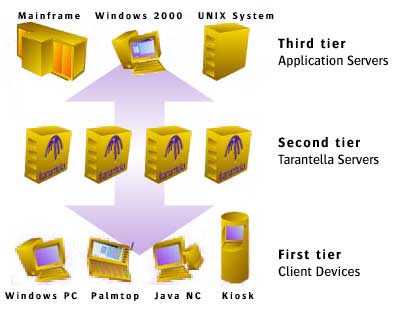
| Read this topic to... |
|---|
|
Tarantella is built around a three-tier architecture model:

Different tiers can reside on the same host (for example, a single UNIX host can act as both a Tarantella server and an application server), but the tiers remain logically independent.
A client device is a piece of hardware that can communicate with Tarantella - using either a web browser with Java™ technology enabled, or the Tarantella Native Client.
The web browser (or Tarantella Native Client) running on the client device communicates with web servers and Tarantella servers on the second tier, and displays the applications that users may run. The Adaptive Internet Protocol (AIP) ensures optimal network usage between the first and second tiers.
Network Computers (NCs) and PCs are examples of client devices.
The second tier may contain a single Tarantella server, or many Tarantella servers configured to form an array.
A Tarantella server is responsible for:
An application server runs users' applications.
When a user clicks a link on their webtop, Tarantella starts the application on an appropriate application server. Output from the application is redirected by the Tarantella server from the application server to the client device.
When you tell Tarantella about an application, you include information about all the application servers that may run the application. Tarantella load balances between the application servers.